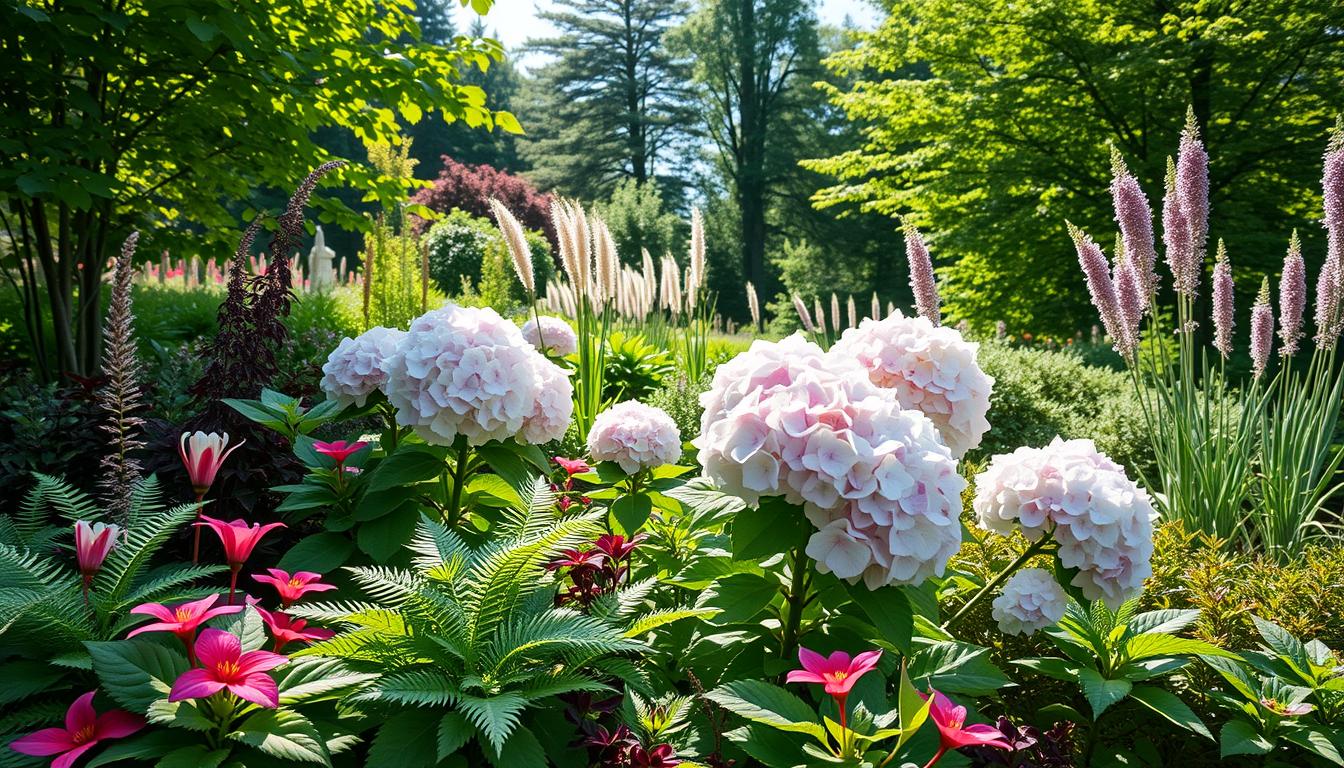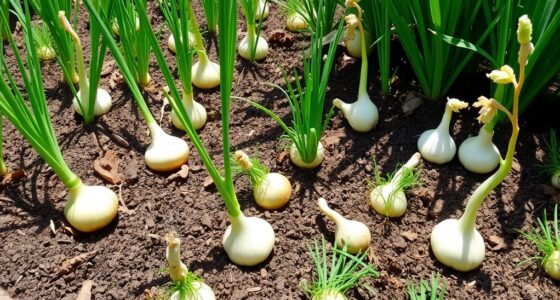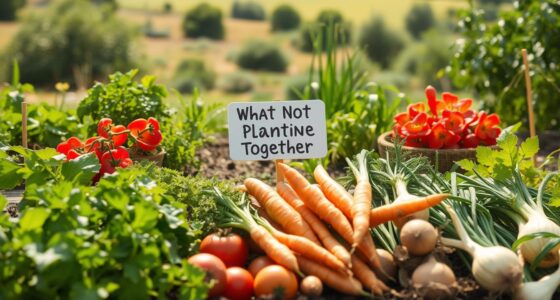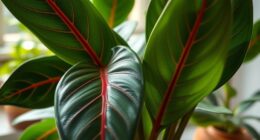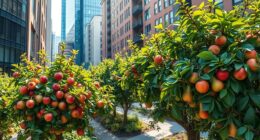Picture yourself walking through a vibrant garden, the air rich with the scent of blooming flowers and the soft rustling of leaves. Hydrangeas, with their luscious blooms, often draw the eye, but their beauty can be enhanced even further by choosing the right companion plants. These companions not only celebrate the hydrangeas’ unique hues but also create a harmonious environment, making your garden a sanctuary of tranquility. Selecting the best plants to grow with hydrangeas allows you to design a space that feels personalized and alive, nurturing both your spirit and the delicate balance of nature. Let’s explore the wonderful world of companion plants for hydrangeas, transforming your garden into a picturesque retreat.
Key Takeaways
- Hydrangeas thrive alongside specific companion plants, enhancing both growth and aesthetics.
- Choosing the best plants to grow with hydrangeas promotes a harmonious garden design.
- Companion planting can improve soil quality and aid in pest control.
- Foliage and flowering plants can beautifully complement hydrangeas.
- Understanding soil and light conditions is essential for successful gardening.
Understanding Hydrangeas and Their Needs
Hydrangeas are a stunning addition to any garden, boasting various species that each have unique requirements. To achieve the best results with your hydrangea plant pairings, understanding these needs is essential. Different types of hydrangeas can enhance your garden’s beauty while creating a vibrant ecosystem of compatible plants.
Different Types of Hydrangeas
The most common species of hydrangeas include Hydrangea macrophylla and Hydrangea paniculata. These varieties have different blooming habits and color variations based on soil pH. Knowing which hydrangeas thrive in your local climate will guide you in deciding what to plant with hydrangeas for the best visual impact.
Optimal Light Conditions
Hydrangeas generally prefer partial shade, especially during the hottest parts of the day. Providing the right amount of sunlight ensures healthy growth and vibrant blooms. When considering hydrangea plant pairings, choose plants that thrive in similar light conditions to create a harmonious garden.
Soil Preferences
Rich, well-drained soil is essential for hydrangeas as it retains moisture while allowing excess water to drain away. Amending your soil with organic matter can enhance its quality, offering an ideal environment for hydrangeas and their companions. Understanding soil preferences will help you in selecting what to plant with hydrangeas to create a flourishing landscape.

| Hydrangea Type | Light Requirement | Soil Preference |
|---|---|---|
| Hydrangea macrophylla | Partial Shade | Moist, Well-drained |
| Hydrangea paniculata | Full Sun to Partial Shade | Well-drained, Rich in Organic Matter |
Best Companion Plants for Hydrangeas
Choosing the right companion plants for hydrangeas enhances both beauty and health in your garden. These plants should align with the specific needs of hydrangeas, creating an aesthetically pleasing and harmonious environment. Below are some excellent planting ideas for hydrangeas that will thrive together and bring vibrancy to your space.
Perennials that Thrive
Perennials such as astilbe and coral bells make excellent companions for hydrangeas. Both of these plants flourish in moist soil, which is critical for hydrangeas. Astilbe offers feathery plumes that add height and texture, while coral bells provide stunning foliage colors that complement the blooms of hydrangeas.
Annuals for Vibrant Color
If you’re looking to introduce seasonal flair, annuals like begonias and petunias are ideal. Begonias provide bright colors and thrive in similar light conditions as hydrangeas. Petunias bloom profusely and come in various shades that can accentuate the hydrangeas, creating a lively display in your garden.
Foliage Plants to Pair
Foliage plants such as hostas are perfect for additional texture and visual interest. Hostas can thrive in partial shade, mirroring the needs of hydrangeas. Their broad leaves create a lush backdrop for the colorful hydrangea blooms, enhancing the overall design of your garden.

| Plant Type | Examples | Benefits |
|---|---|---|
| Perennials | Astilbe, Coral Bells | Thrive in moist conditions, add height and color |
| Annuals | Begonias, Petunias | Provide vibrant seasonal color, complement blooms |
| Foliage Plants | Hostas | Add texture, thrive in similar light conditions |
Color Harmony with Hydrangeas
Creating a visually appealing hydrangea garden requires an understanding of color harmony in gardens. Utilizing complementary and contrasting color schemes can elevate the beauty of your landscape. By selecting blooming plants that harmonize with your hydrangeas, you achieve a cohesive and inviting atmosphere.
Complementary Color Schemes
Choose flowers that exhibit colors complementing your hydrangeas. If you have blue hydrangeas, consider planting golden-yellow daylilies nearby. For pink hydrangeas, deep purple asters provide a vibrant contrast. These combinations are essential for grounding the hydrangea’s beauty while enhancing their natural allure.
Contrasting Foliage
Incorporating contrasting foliage can enhance the overall appeal of your garden. Plants such as Japanese maples lend structure and texture with their striking leaves. The vivid autumn colors of these trees juxtapose beautifully against the hydrangea blooms, adding depth and richness to your landscape.
Seasonal Color Changes
Hydrangeas are unique as they undergo seasonal changes that impact color. Early blooms often differ from those appearing later in the season. By integrating plants that exhibit their own seasonal transformations, such as perennial grasses that turn golden in fall, you maintain ongoing interest and excitement in your garden. These transitions provide not only visual delight but also enhance hydrangea landscaping tips for an ever-evolving landscape.
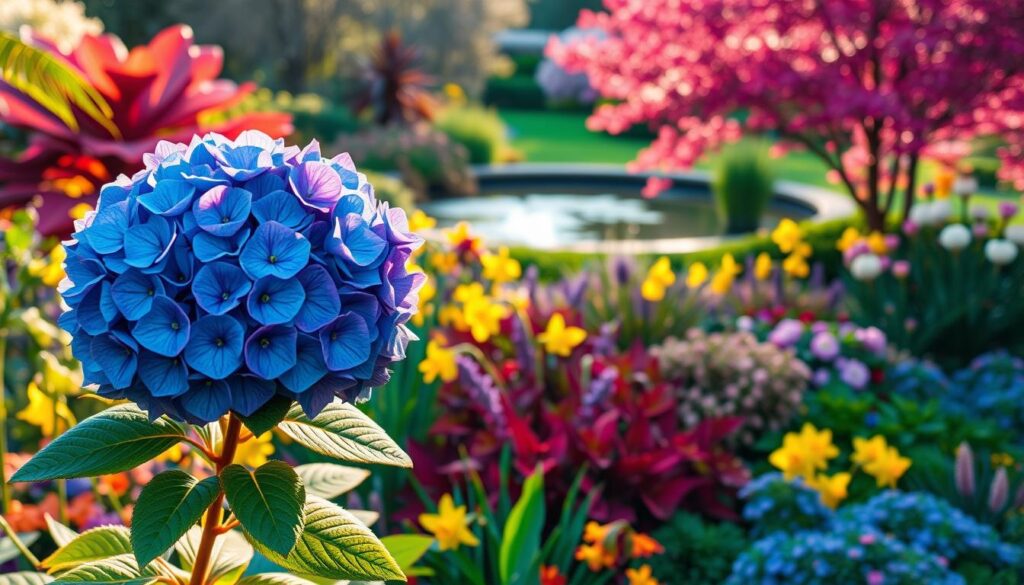
Companion Planting Benefits
When considering your garden’s layout, you may want to explore the benefits of companion planting. This technique not only boosts the vitality of your hydrangeas but also enhances the overall aesthetic and health of your garden. Smart plant pairings can create a synergistic environment, where neighbors thrive alongside one another.
Enhanced Growth and Health
Plants in harmony often experience enhanced growth and health. When you utilize beneficial plant pairings, you can promote nutrient sharing and soil moisture stabilization. This cooperative interaction allows hydrangeas to flourish and maximize their potential. As you observe your garden’s evolution, the improvement in vigor becomes evident.
Natural Pest Control
Incorporating companion plants like alliums or marigolds can provide an organic method for pest control. These plant pairings serve as natural repellents, deterring unwanted insects from damaging your hydrangeas. In this way, you contribute to a healthier ecosystem in your garden, reducing the need for chemical interventions.
Improved Soil Quality
Companion planting significantly improves soil quality, enriching the ecosystem essential for all plants. Diverse flora contributes organic matter, which enhances soil structure and nutrient availability. This positive change can further benefit hydrangeas, leading to robust growth and a vibrant display of blooms.
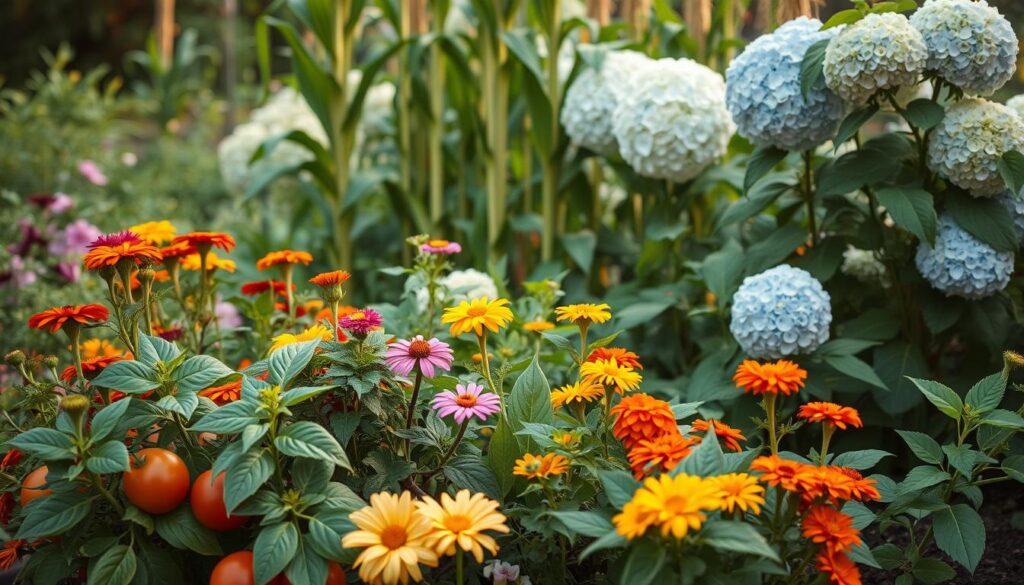
Ideal Shrubs to Pair with Hydrangeas
When incorporating hydrangeas into your garden, choosing the right shrubs can significantly enhance your landscape’s visual appeal. Consider a range of flowering, evergreen, and deciduous shrubs that not only complement hydrangeas but also thrive alongside them. These shrub pairings provide structural interest and seasonal beauty, making them some of the best plants to grow with hydrangeas.
Flowering Shrubs
Flowering shrubs like azaleas and rhododendrons offer vibrant blooms that can align with the splendid flowering of hydrangeas. These shrubs typically bloom in spring, creating a cascading effect of color that elevates the aesthetic of your garden. Their blossoms enhance hydrangea plant pairings by providing complementary hues while ensuring continued interest once hydrangeas start to fade.
Evergreen Shrubs
Evergreen plants such as boxwoods and holly are essential for maintaining year-round structure in your garden. These shrubs provide a solid backdrop for the changing colors of hydrangeas through each season. Their foliage serves to highlight the beauty of hydrangeas, making them valuable companions in your landscape design.
Deciduous Varieties
Deciduous shrubs, like spirea and ninebark, offer seasonal interest with their striking foliage and blooms. These shrubs typically bloom later in the summer, providing a beautiful contrast to the early blooming hydrangeas. By selecting the right deciduous varieties, you ensure that your garden remains captivating throughout the growing season, embodying some of the best plants to grow with hydrangeas.
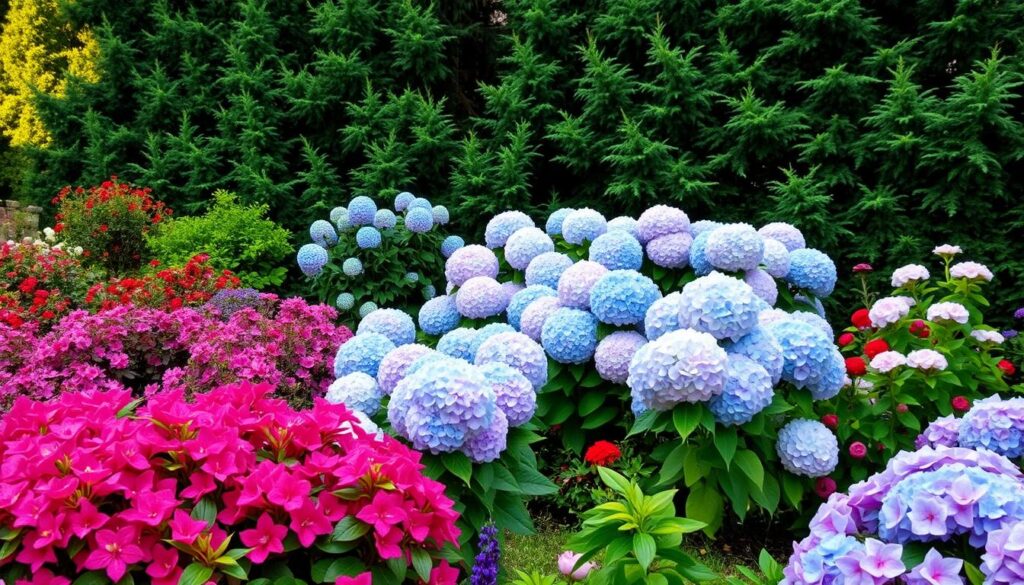
Annual Flowers That Work Well
Incorporating annuals for vibrant color can transform your garden, especially alongside beautiful hydrangeas. These lively flowers add seasonal interest and can significantly enhance your landscape. Consider the following annuals that pair excellently with hydrangeas, each bringing something unique to the table.
Petunias for a Splash of Color
Petunias are a fantastic choice for adding stunning hues next to hydrangeas. Their lush blooms come in various shades, allowing you to create a dynamic display. They thrive in the same light conditions as hydrangeas, making them a natural fit. Petunias will not only uplift the color palette of your garden but also attract pollinators, contributing to a balanced ecosystem.
Marigolds for Pest Resistance
In addition to their cheerful appearance, marigolds are a functional companion to hydrangeas. These vibrant flowers possess natural pest-repelling qualities, deterring harmful insects that might otherwise target your hydrangeas. Planting marigolds alongside your favorite blooms serves a dual purpose—enhancing garden beauty while keeping your plants healthy. This makes them an excellent choice for what to plant with hydrangeas.
Nasturtiums’ Edible Benefits
Nasturtiums offer not only striking flowers but also edible leaves and blooms, enriching your garden experience. Their sometimes peppery taste adds zing to salads, and their vibrant colors can stand out beautifully alongside hydrangeas. This versatility makes nasturtiums an ideal annual for vibrant color, while also providing culinary advantages. They can offer a delightful addition to your garden, where aesthetics and utility coexist harmoniously.

Foliage Companions for Texture
To create an inviting hydrangea garden design, consider integrating a variety of foliage plants to pair alongside your hydrangeas. Textural diversity enhances the overall beauty and depth of your landscape, making it captivating throughout the seasons.
Hostas for Shade
Hostas thrive in shaded areas where hydrangeas often flourish. Their broad leaves create a striking contrast against the more delicate hydrangea blooms. With various shades of green and unique leaf shapes, hostas can significantly contribute to the aesthetic appeal of your garden. You can enjoy the lush greenery they provide year-round.
Ferns for Moist Areas
Ferns are excellent companions for hydrangeas, particularly in moist areas. They not only thrive in similar conditions but also bring a soft, feathery texture that adds depth to your hydrangea garden design. Varieties like lady ferns or ostrich ferns create beautiful contrasts and harmonize well with hydrangea foliage.
Grasses for Movement
Incorporating ornamental grasses introduces a dynamic element to your landscape. Grasses such as miscanthus or fountain grass sway gently in the breeze, adding movement and interest. Their varied heights and colors provide a fantastic backdrop to your hydrangeas, enriching the sensory experience of your garden.

Ground Covers to Consider
Using proper ground covers can greatly benefit your hydrangea garden by improving aesthetics and minimizing maintenance. By selecting suitable low maintenance plants, you can create a lush garden that harmonizes beautifully with your hydrangeas. Here are some excellent options to consider:
Creeping Thyme for Aromatic Appeal
Creeping thyme not only provides aromatic appeal but also enhances soil coverage around your hydrangeas. This ground cover flourishes in well-drained soil and sunny locations, making it an ideal companion. The tiny purple flowers attract pollinators, adding extra charm to your garden.
Ajuga for Colorful Foliage
Ajuga, or bugleweed, showcases vibrant foliage that can beautifully complement your hydrangeas. Its rich color variations and low-growing habit make it a stylish choice among ground covers for hydrangeas. Ajuga excels in partial shade, ensuring that even less sunny spots maintain visual interest.
Vinca Minor for Low Maintenance
If you’re looking for low maintenance plants, consider Vinca minor. This hardy ground cover requires minimal care while providing lovely green leaves and cheerful purple flowers. Vinca minor thrives in various soil types and is particularly useful for filling in areas around hydrangeas without demanding much attention.
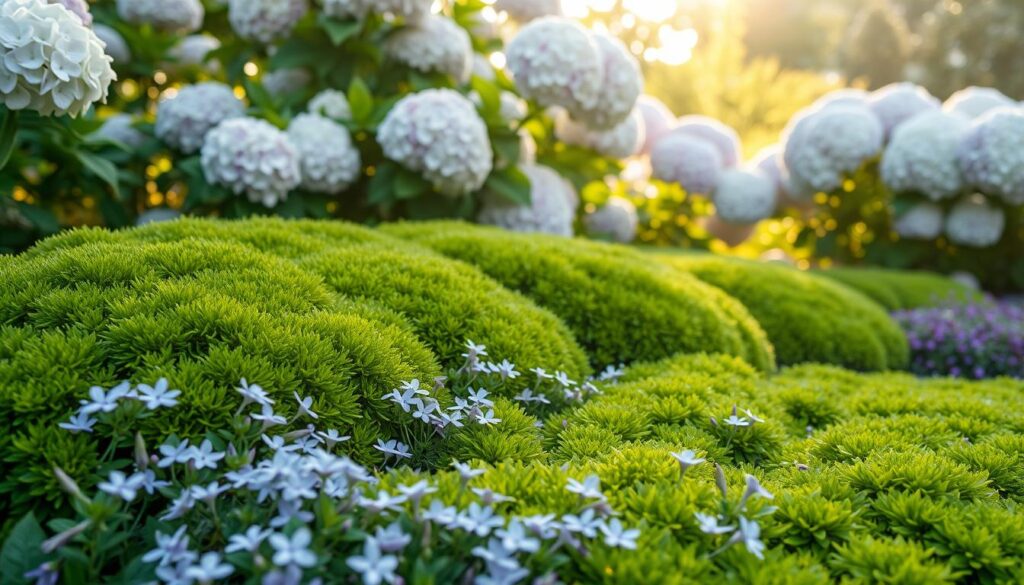
| Ground Cover | Key Features | Maintenance Level | Ideal Conditions |
|---|---|---|---|
| Creeping Thyme | Aromatic foliage, attracts pollinators | Low | Sunny, well-drained soil |
| Ajuga | Colorful foliage, purple blooms | Low | Partial shade to full sun |
| Vinca Minor | Hardy, purple flowers | Very Low | Varied soil types |
Vegetables to Plant Near Hydrangeas
Choosing what to plant with hydrangeas can greatly influence the health and growth of your garden. Interplanting compatible vegetables alongside hydrangeas not only enhances aesthetics but also promotes nutrient sharing and can improve yields. By selecting the right vegetables, you can create a harmonious garden that thrives in every season.
Companion Vegetables for Nutrient Sharing
Some vegetables flourish when planted near hydrangeas. Consider these compatible vegetables:
- Tomatoes – They appreciate the same moisture levels hydrangeas require, making them excellent neighbors.
- Leafy Greens – Varieties like spinach and lettuce benefit from the shade provided by hydrangeas, especially during the heat of summer.
- Peppers – These plants enjoy similar conditions and can share nutrients effectively with nearby hydrangeas.
Benefits of Interplanting
Combining hydrangeas with very specific vegetables brings numerous benefits:
- Increased nutrient availability enhances the growth of vegetables.
- The shade from hydrangeas protects more delicate crops from harsh sunlight.
- Reducing weed growth significantly through a denser planting scheme.
Guidelines for Spacing
Proper spacing is essential for ensuring the success of your garden. Follow these guidelines:
- Allow at least 2-3 feet of space between hydrangeas and vegetables to prevent overcrowding.
- Consider the mature size of each plant when planning your layout.
- Maintain consistent moisture levels for both hydrangeas and vegetables by using mulch to retain soil moisture.
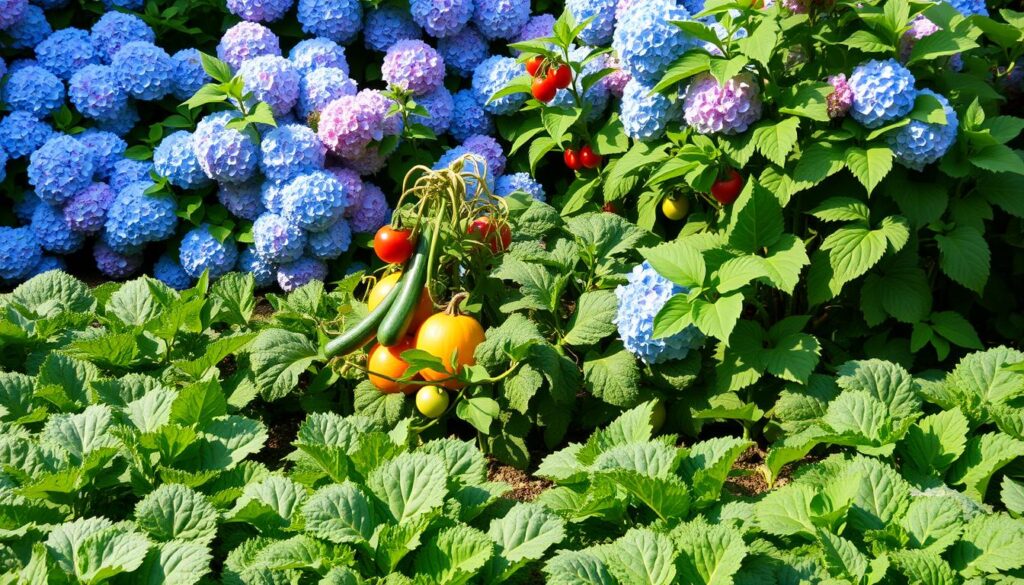
Designing Your Hydrangea Garden
Creating a stunning hydrangea garden design involves thoughtful spacing and strategic placement of your hydrangeas. This planning not only enhances the overall aesthetic but also ensures the best growth conditions for your plants. Incorporating essential landscaping tips can elevate your garden’s design, making it both visually appealing and functional.
Considering Spacing and Placement
When designing your hydrangea garden, pay attention to the spacing between each plant. Adequate room allows for air circulation and sunlight exposure, which are vital for healthy blooms. As a general rule, hydrangeas should be spaced about 3-5 feet apart. This distance can vary depending on the variety and growth habit of your hydrangeas. Place taller hydrangeas at the back or center of your garden bed to prevent overshadowing shorter plants. This will create a layered effect, adding depth to your garden.
Layering for Visual Interest
To enhance visual interest, consider layering your plants. By combining hydrangeas with varying heights, you create an engaging view from multiple angles. Use shorter perennials, like daylilies or hostas, in front of your hydrangeas. This approach provides a dynamic look while showcasing the beautiful blooms of your hydrangeas. Mixing foliage textures and colors further enriches the design, keeping your garden exciting and vibrant throughout the growing seasons.
Seasonal Considerations
A successful hydrangea garden design reflects seasonal changes, ensuring beauty year-round. Choose companion plants that bloom at different times, providing color when hydrangeas may not. Selecting evergreens maintains structure and greenery during winter months. Consider the seasonal growth patterns of your plants so that your garden remains engaging regardless of the time of year. This strategy, paired with sound landscaping tips, will create a captivating garden that delights you in every season.

Maintaining a Healthy Ecosystem
Creating a healthy garden ecosystem enhances the growth of all your plants and promotes a vibrant environment. To achieve this, consider integrating methods that attract various organisms, thereby increasing biodiversity in gardening. This diversity not only supports your hydrangeas but also ensures a balanced ecosystem.
Attracting Pollinators
Pollinators play a crucial role in maintaining a healthy garden ecosystem. By planting flowers such as echinacea and bee balm, you can draw in bees, butterflies, and other beneficial pollinators. These creatures are vital for plant reproduction and contribute significantly to the overall biodiversity of your garden.
Encouraging Beneficial Insects
Incorporating plants that attract beneficial insects can help create a natural balance in your garden. Ladybugs, lacewings, and predatory wasps control pest populations, reducing the need for chemical interventions. Techniques like interplanting companion species solidify your approach toward a more resilient garden, creating a healthy garden ecosystem.
Encouraging Biodiversity
Biodiversity in gardening enhances resilience, making your plants less susceptible to disease and pest infestations. Incorporate a mix of annuals, perennials, vegetables, and herbs to cultivate a dynamic environment. This varied planting strategy promotes a diverse array of species, allowing your hydrangeas and other plants to thrive.
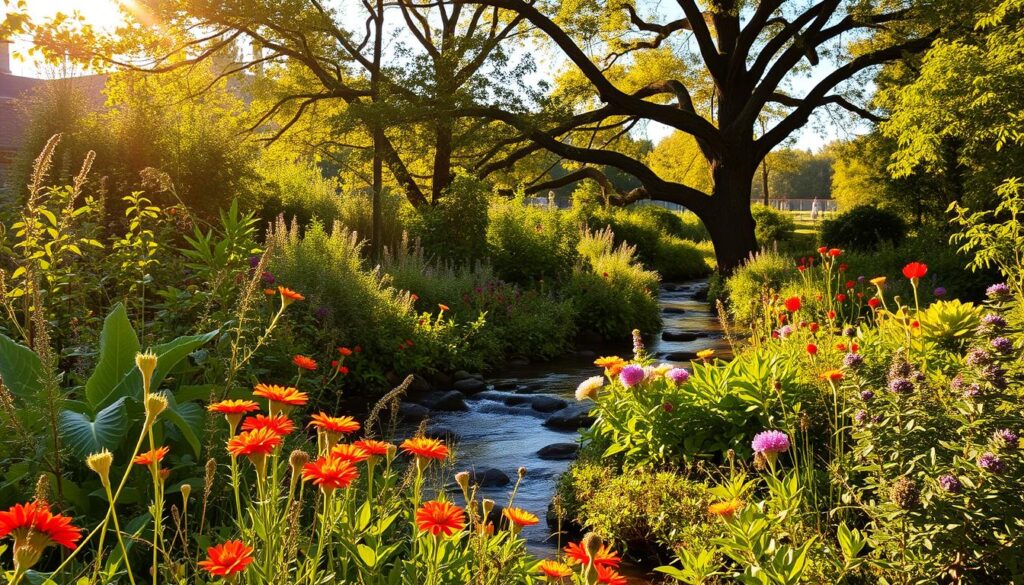
| Plant Type | Attractor | Benefit |
|---|---|---|
| Echinacea | Bees | Pollination and vibrant colors |
| Bee Balm | Butterflies | Attractive blooms boosting nectar supply |
| Marigolds | Predatory insects | Pest control and vibrant foliage |
| Nasturtiums | Beneficial bugs | Confusion of pests and edible flowers |
Seasonal Care for Hydrangeas and Companions
Proper seasonal care for hydrangeas and their companion plants enhances their growth and overall health. Following targeted hydrangea maintenance tips throughout the year ensures that your garden remains vibrant and flourishing.
Spring Preparations
As spring arrives, focus on preparing your hydrangeas for the growing season. Begin by pruning any dead or damaged stems to encourage healthy new growth. Apply a layer of mulch around the base of the plants to help retain moisture and suppress weeds. This is also a great time to assess the soil’s pH, ensuring it meets the specific needs of your hydrangeas.
Summer Maintenance
During the summer months, regular watering becomes essential to keep hydrangeas hydrated during hot weather. Ideally, you should water deeply and consistently, especially for newly planted specimens. Fertilizing every few weeks with a balanced fertilizer promotes lush foliage and vibrant blooms. Keep an eye out for pests, and address any potential issues promptly.
Fall Cleanup
As autumn approaches, it’s vital to carry out a thorough cleanup. Remove spent flowers and any dead leaves to prevent disease and pest problems. Before the first frost, you may also want to cover the base of the plants with a protective layer of mulch or leaves, helping them withstand the winter temperatures. This fall cleanup is crucial in ensuring your hydrangeas return healthy in the next growing season.
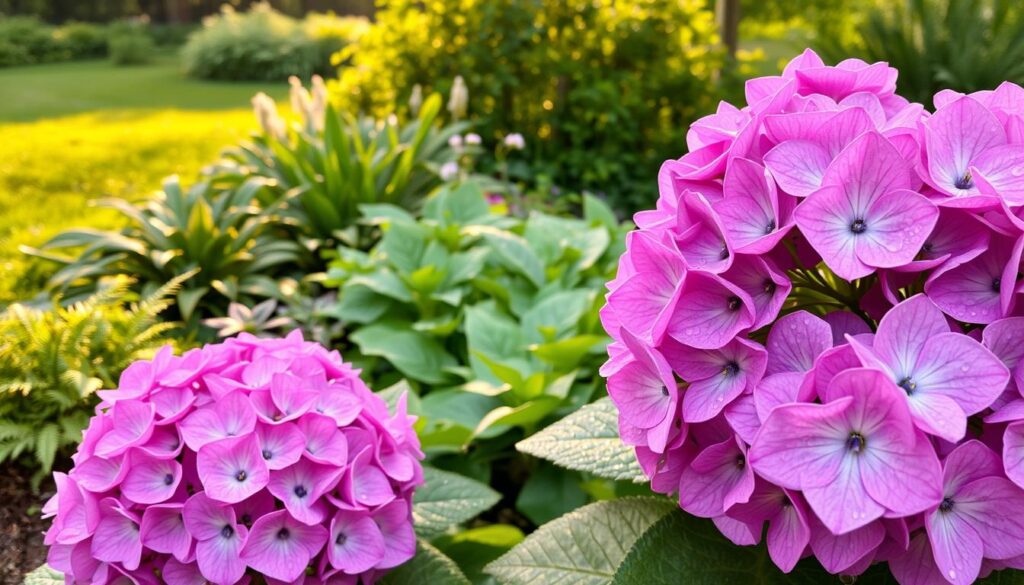
Troubleshooting Common Issues
As you embark on your journey of hydrangea care, being aware of common challenges is essential. Regular inspections of your plants can help you identify specific problems early on, which is crucial for ensuring their longevity and beauty. From dealing with pest infestations to recognizing signs of diseases, understanding these issues will pay dividends in maintaining a vibrant garden.
Identifying Pests and Diseases
Keeping a vigilant eye out for pests and diseases can save your hydrangeas from needless stress. Signs such as wilting leaves, discolored spots, or the presence of aphids and spider mites indicate an issue. For example, powdery mildew is a common fungal disease that thrives in humid conditions, leading to white, powdery spots on foliage. Addressing these threats promptly allows your garden to flourish.
Nutrient Deficiencies
A lack of essential nutrients can impede the health of your hydrangeas. Symptoms such as yellowing leaves or stunted growth often signal deficiencies in nitrogen, phosphorus, or potassium. Regularly testing your soil can provide insights into what nutrients might be lacking, enabling you to amend your soil accordingly to support flourishing plants.
Environmental Factors to Watch
Environmental changes are another important aspect of troubleshooting gardening issues. Sudden drops in temperature, inadequate sunlight, or fluctuating moisture levels can affect your plants significantly. Being conscious of these factors and adjusting care routines—like providing shade during extreme heat or ensuring adequate watering—will help sustain your hydrangeas and their companions, promoting a healthy garden ecosystem.
